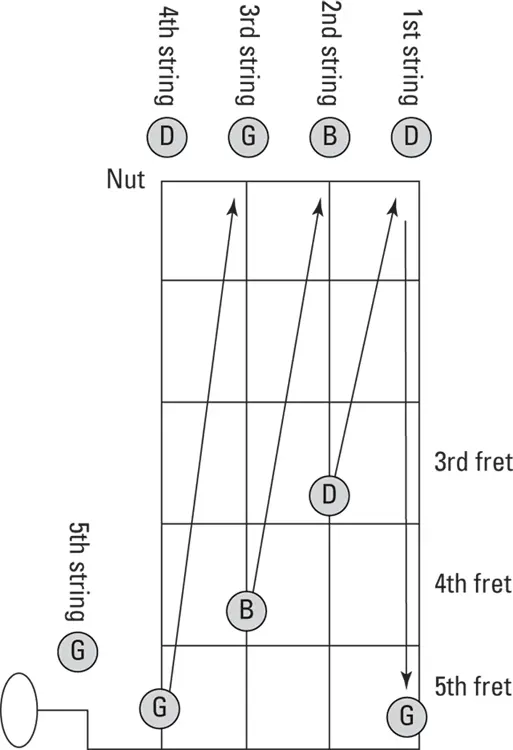1 ...6 7 8 10 11 12 ...16 In Chapters 4, 10, and 12, I discuss the unique techniques and skills you need to accompany other pickers and singers on familiar bluegrass and old-time tunes in informal jam sessions. I also cover some of the unspoken ground rules of jam etiquette to make your transition into group playing go smoothly.
Meeting other banjo lovers
You may be amazed at how many opportunities you have to share your enthusiasm for the banjo with other like-minded players. From finding a teacher to attending a workshop, camp, or festival, you can have more fun with the instrument and become a better player faster by connecting with others who share your enthusiasm for the banjo. As a new player, don't wait until you've already acquired some playing skills before seeking help from others. You'll become a better player much more quickly by seeking out help at the very beginning of your banjo adventure. In Chapter 12, I talk about the world of banjo that lies beyond your doorstep.
 Camps and workshops are often designed for all levels of students. If you already play, you can recharge your banjo-picking batteries at a regional camp or workshop where you can hang out with the banjo stars, make many new friends, and come away with new playing ideas that will keep your hands busy for months to come.
Camps and workshops are often designed for all levels of students. If you already play, you can recharge your banjo-picking batteries at a regional camp or workshop where you can hang out with the banjo stars, make many new friends, and come away with new playing ideas that will keep your hands busy for months to come.
Keeping your banjo sounding great
Banjos are much more adjustable than other stringed instruments such as the guitar or bass. However, you don't have to become an accomplished, all-knowing, instrument-repair person to keep your instrument in top shape.
 Keeping fresh strings on your instrument is the most important thing you can do to keep your banjo running right. After a few weeks or months of playing, your strings will inevitably become harder to tune — or they may even break. Keep an extra set of strings handy in your case along with a small pair of wire cutters, and you'll be ready for all contingencies!
Keeping fresh strings on your instrument is the most important thing you can do to keep your banjo running right. After a few weeks or months of playing, your strings will inevitably become harder to tune — or they may even break. Keep an extra set of strings handy in your case along with a small pair of wire cutters, and you'll be ready for all contingencies!
You may also want to check out all the movable parts on your banjo every couple of months. For example, keeping the head tight keeps your banjo sounding bright and loud, and checking to see that the bridge is in just the right place on the banjo head keeps your fretted notes in tune. I cover everything you need to know about these topics, as well as determining when you need to seek out professional advice, in Chapter 15.
Chapter 2
IN THIS CHAPTER
 Sizing up strings and frets for G tuning
Sizing up strings and frets for G tuning
 Tuning your banjo by ear: Relative tuning
Tuning your banjo by ear: Relative tuning
 Using a tuner or another instrument: Reference tuning
Using a tuner or another instrument: Reference tuning
 Access the audio tracks and video clips at www.dummies.com/go/banjo
Access the audio tracks and video clips at www.dummies.com/go/banjo
Question: “What's the difference between a banjo and a motorcycle?”
Answer: “You can tune a motorcycle.”
This unfortunate but frequently recited banjo joke speaks to a greater truth: The banjo can be one of the most difficult and frustrating of all stringed instruments to tune. One of the first steps to becoming a great player is getting tuned in and staying that way throughout a practice or playing session.
With just a bit of practice, using this section as a guide, you can master this all-important but sometimes elusive skill, making it possible for you to play at home without driving your loved ones insane. And when it's time to play with other musicians in a jam session, they'll be so grateful that you took the time to figure out how to tune your banjo that they just might let you play “Cripple Creek” with them twice at a slow speed.
To tune the banjo, you raise or lower the amount of tension of each string to match the sound of another banjo string or to match a reference note provided by another instrument or an electronic tuner. You adjust each string by turning its corresponding tuning peg. In this section, you get familiar with several different methods to tune your banjo, so you have absolutely no excuse but to tune in and pick on!
 Like all other elements of banjo playing, tuning is a skill that gets easier with practice and the passage of time. Being able to distinguish one note from another isn't a mysterious psychic ability that you either are or aren't born with — tuning is a learned skill. Keep actively listening to how the sounds of the strings change as you turn the pegs. Don't be afraid to ask others for advice if you're unsure about whether a string is in tune, even when playing with others in a jam session. Other musicians want you to be in tune just as much as you want to be!
Like all other elements of banjo playing, tuning is a skill that gets easier with practice and the passage of time. Being able to distinguish one note from another isn't a mysterious psychic ability that you either are or aren't born with — tuning is a learned skill. Keep actively listening to how the sounds of the strings change as you turn the pegs. Don't be afraid to ask others for advice if you're unsure about whether a string is in tune, even when playing with others in a jam session. Other musicians want you to be in tune just as much as you want to be!
G Tuning: Getting Your Strings in Order
Although banjo players use a variety of tunings to play different kinds of songs and to create different moods on their instrument, the most frequently used tuning is called G tuning (which is also the type of tuning that's used in most of this book with the exception of many of the old-time tunes covered in Chapter 8). With this tuning, the five open strings of the banjo are tuned to the notes of a G major chord (a chord is a collection of three or more notes played together; I talk more about chords in Chapter 3).
Here are the pitches used for each string in G tuning:
5th string: G
4th string: D
3rd string: G
2nd string: B
1st string: D
Note that only three different pitches are used in G tuning: G, B, and D. These three notes make up the G major chord. The 1st-string D and 5th-string G are one octave higher in pitch than their 4th- and 3rd-string counterparts. Your ears hear the two D notes and the two G notes as being essentially the same, but you can also hear that the 1st and 5th strings are higher in pitch. Musicians long ago decided to assign the same letter name to pitches that you hear in this way, but they also recognized that the two D's and the two G's aren't exactly the same pitch. They're one octave apart, with the octave being the point where that same note is repeated again but at a higher pitch.
 Figure 2-1 shows the pitches of each string in G tuning along with a fretboard image summarizing the relative tuning relationships between the strings (which I cover in the next section). You can check out Audio Track 1 to hear the pitch of each banjo string in G tuning.
Figure 2-1 shows the pitches of each string in G tuning along with a fretboard image summarizing the relative tuning relationships between the strings (which I cover in the next section). You can check out Audio Track 1 to hear the pitch of each banjo string in G tuning.

Illustration by Wiley, Composition Services Graphics
FIGURE 2-1:To tune the banjo in G tuning using relative tuning, you fret a string as shown to match the pitch of the next highest open string.
Читать дальше

 Camps and workshops are often designed for all levels of students. If you already play, you can recharge your banjo-picking batteries at a regional camp or workshop where you can hang out with the banjo stars, make many new friends, and come away with new playing ideas that will keep your hands busy for months to come.
Camps and workshops are often designed for all levels of students. If you already play, you can recharge your banjo-picking batteries at a regional camp or workshop where you can hang out with the banjo stars, make many new friends, and come away with new playing ideas that will keep your hands busy for months to come. Sizing up strings and frets for G tuning
Sizing up strings and frets for G tuning Figure 2-1 shows the pitches of each string in G tuning along with a fretboard image summarizing the relative tuning relationships between the strings (which I cover in the next section). You can check out Audio Track 1 to hear the pitch of each banjo string in G tuning.
Figure 2-1 shows the pitches of each string in G tuning along with a fretboard image summarizing the relative tuning relationships between the strings (which I cover in the next section). You can check out Audio Track 1 to hear the pitch of each banjo string in G tuning.











